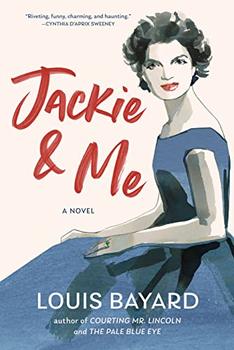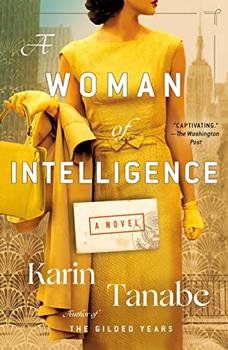Summary | Excerpt | Reviews | Beyond the book | Read-Alikes | Genres & Themes | Author Bio

A Novel Starring Rita Hayworth and Orson Welles
by Jerome CharynJerome Charyn made his name as an author of detective novels, and over the years he has taken his criminal muse to some unlikely places. A good example is his 2010 novel The Secret Life of Emily Dickinson, where, among other activities, the author has the poetess figure out a spate of burglaries and fall desperately in love with not one, but two Victorian malefactors. Some were unimpressed with such flights, whose biographical basis was, needless to say, rather flimsy. Charyn is on safer ground introducing similar elements in his latest novel, a fictional retelling of the relationship between Orson Welles and Rita Hayworth (the titular "Big Red"). As biographical subjects, and as cinematic personae, Welles and Hayworth furnish more apt detective-story material than Amherst's Belle.
The other hat the author wears here is that of the cinéaste. Charyn is also a film expert and professor, and wrote an engaging, if somewhat rambling, history of Hollywood: Movieland (1989). Big Red, then, must have seemed a perfect fit, combining his standard narrative vehicle with his scholarly interests. Indeed, the narrator, Rusty Reburn, a dirt digger for the Columbia studio moonlighting as a movie reviewer, is a veritable incarnation of this compact between the private eye and the film critic.
The good news is the combination works. Where intrigue and film discussion (occasionally somewhat elegiac in tone) hold each other in balance, the book flows pleasantly. It is when the sleuth gives way to the diatribist — notably towards the book's middle — that the result can be somewhat slow. The narrative then sometimes sounds like it belongs more to a documentary in tribute of Welles's filmmaking than to a novel.
Apart from the reanimation of some iconic films, and the elements from detective fiction, there is of course the love story. In the latter, Hayworth comes across as the indisputably superior party. Beautiful, vulnerable, devoted, insecure, she is rather the opposite of her on-screen persona as femme fatale, and cuts a more sympathetic figure than the charming but egocentric genius, Welles. Indeed, the spotlight is consistently turned on Rita, whose beguiling bodily motion is the object of frequent lyrical descriptions: "Rita was an enchantress, a girl with
diamonds in her legs, as she moved with a furious glow that left
every other dancer in her wake."
These are the main ingredients of the plot. But what is the book's thrust? Its presumed subject is the struggle of talent, artistic vision and integrity against greed. In the noir, even as the characters go about solving cases, having fights, getting drunk or falling in love as the case may be (and all this does happen, more or less, in Big Red), one catches in the background the hum of power's pitiless machinery rolling along on its bone-crushing course, with money doing the talking. Here, this background is provided, in caricature, by the studio apparatus of the mogul era, whose main representative in the novel is head of Columbia Pictures, Harry Cohn. It is he who sets the plot in motion by hiring Rusty to pose as Hayworth's secretary while acting as his spy.
Charyn elaborates on this conflict in an author's note, where he describes the narrator as "an outlaw" and "the perfect foil" to Cohn and the system he stands in for (whose probably well-known offenses are, in any case, discernible in the course of the novel). Of course, that's one possible perspective. Another is that Rusty is a deferential nod to today's presiding sensibilities. Indeed, Rusty is queer, a defender (and even savior) of minorities, a feminist and a general upholder, by the looks of it, of every right-thinking cause ever conceived. All this, of course, is fine. The only problem is that her causes are contemporary Hollywood's pet causes too. This makes her not so much an "outlaw" as a perfect 21st century Hollywoodian beamed back to the postwar era, so we, the audience, can marvel at the contrast. This is a bit too easy.
Cohn offers a thousand dollars to anyone prepared to explain "what the hell" Welles's cut of The Lady from Shanghai "was about!" Indeed, a preference for realism and linearity is perhaps the one prejudice Hollywood has retained. However, Charyn himself, quite capable in the good old days of the sort of operatic metafiction whose mere plot synopsis — or rather the very idea of presenting one — was enough to give you a headache, offers simpler fare here. Big Red is not the worse for it.
![]() This review
first ran in the September 21, 2022
issue of BookBrowse Recommends.
This review
first ran in the September 21, 2022
issue of BookBrowse Recommends.

If you liked Big Red, try these:

by Louis Bayard
Published 2023
Master storyteller Louis Bayard delivers a surprising portrait of a young Jackie Kennedy as we've never seen her before.

by Karin Tanabe
Published 2022
From "a master of historical fiction" (NPR), Karin Tanabe's A Woman of Intelligence is an exhilarating tale of post-war New York City, and one remarkable woman's journey from the United Nations, to the cloistered drawing rooms of Manhattan society, to the secretive ranks of the FBI.
Your guide toexceptional books
BookBrowse seeks out and recommends the best in contemporary fiction and nonfiction—books that not only engage and entertain but also deepen our understanding of ourselves and the world around us.